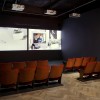Ever since I stumbled across a book of his work, I’ve been a big admirer of Philip-Lorca DiCorcia. His images are mysterious and cinematic, and often blur the line between documentary practice and fiction.
In his career thus far, he has adopted different approaches to photographing people. His early work depicted seemingly innocuous domestic scenes somehow imbued with possibility and teasing ambiguity. Later, in the series Hustlers, male prostitutes were propositioned and paid as they would be for sex acts, yet photographed within environments with all the strict control and arrangement of a film set. His 1999 series Heads was created on the streets of New York: dramatically lit, observed portraits were made without the subjects’ knowledge or permission, but remain strangely intimate.
Most recently, the David Zwirner Gallery in London hosted DiCorcia’s work in an exhibition that borrows its title from John Steinbeck’s novel East of Eden. Steinbeck’s novel is ambitious in scope and draws heavily upon the Book of Genesis, including themes of self-destruction, redemption and guilt. DiCorcia began the series in 2008, drawing influence from his perception of contemporary America at the end of the Bush era, a period, as he saw it, of great disillusionment.
Spread over the gallery’s two floors, some 14 large scale colour photographs make up the exhibition. Whilst each picture is powerful individually, the series as a whole creates a certain psychological ambience. There is a mix of interiors and exteriors; the urban and the wild. Scenes of suburbia now ubiquitous with American life feature: two photographs depict houses, void of human presence as though deserted, as a star-spangled banner hangs limply outside. There is a peculiar sense of stillness that permeates the series: the kind of eerie calm that either precedes a significant event or follows in its aftermath.
Sylmar, California depicts a scene that seems to toy with one the great American clichés. A lone cowboy sits on horseback, with a great expanse of dramatic wilderness spread out before him. This landscape however is a scarred environment, seared by forest fires. Beautiful yet dark, the idealised vision of the Great West is transformed into something mournful, and almost post apocalyptic.
The photographs featuring people often depict individuals caught in moments of trance-like reflection or preoccupation. They stare into space, the nature of their contemplation unknown. In one such image, an elderly lady sits on a bed, and we follow what we perceive her line of vision to be yet are unsure what she is looking at. Is she gazing at her reflection, or the scene outside? Whichever it may be, she seems oblivious to the storm raging on the TV set, her hand resting on the bed beside her, somehow emphasizing her solitude.
Much like Steinbeck’s novel, DiCorcia’s East of Eden references the Book of Genesis through photography. The somewhat hectic Upstate shows an apple tree rising up, amid dense foliage, the red apples visible on the branches. Another image, Epiphany, swaps the serpent from the story of Adam and Eve for that of a pole dancer, sliding down a pole in an almost impossible pose.
Juxtaposition of individual photographs in the show has a profound impact, merging a sensation of isolation with a strangely unsettling sense of calm. One particularly resonant image is that of a pair of roads stretching across a wide, open plain. Tiny vehicles move along, their small size altogether insignificant compared to the epic scale of what surrounds them. What could be a liberating portrayal of freedom and space appears instead as more a lonely, claustrophobic scene – something altogether more frightening.











